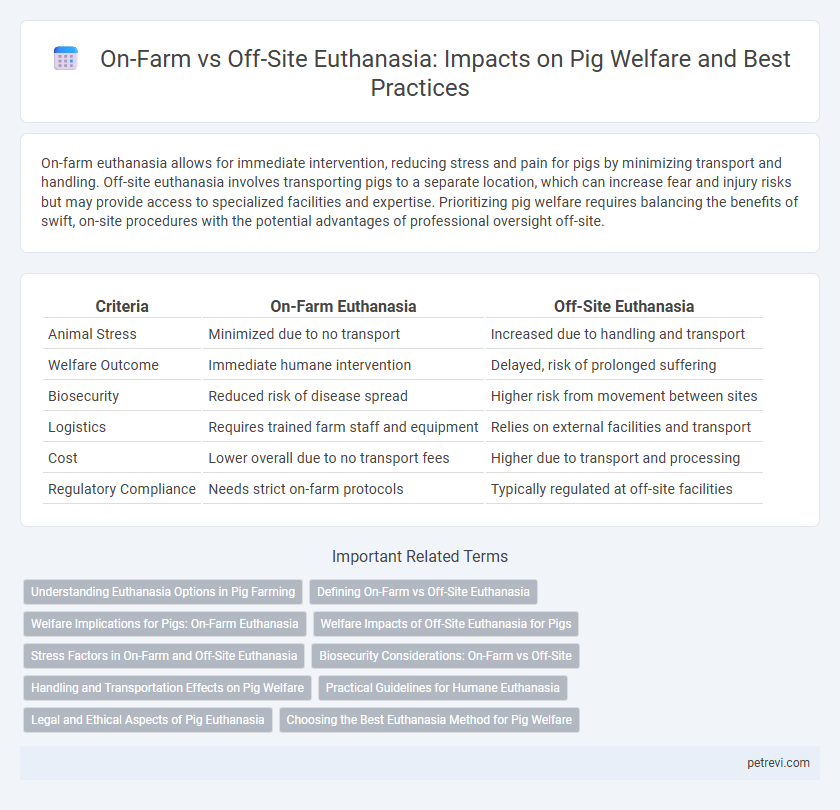On-farm euthanasia allows for immediate intervention, reducing stress and pain for pigs by minimizing transport and handling. Off-site euthanasia involves transporting pigs to a separate location, which can increase fear and injury risks but may provide access to specialized facilities and expertise. Prioritizing pig welfare requires balancing the benefits of swift, on-site procedures with the potential advantages of professional oversight off-site.
Table of Comparison
| Criteria | On-Farm Euthanasia | Off-Site Euthanasia |
|---|---|---|
| Animal Stress | Minimized due to no transport | Increased due to handling and transport |
| Welfare Outcome | Immediate humane intervention | Delayed, risk of prolonged suffering |
| Biosecurity | Reduced risk of disease spread | Higher risk from movement between sites |
| Logistics | Requires trained farm staff and equipment | Relies on external facilities and transport |
| Cost | Lower overall due to no transport fees | Higher due to transport and processing |
| Regulatory Compliance | Needs strict on-farm protocols | Typically regulated at off-site facilities |
Understanding Euthanasia Options in Pig Farming
On-farm euthanasia allows immediate and humane intervention for terminally ill or injured pigs, minimizing stress and transportation-related distress. Off-site euthanasia, performed at specialized facilities, provides access to advanced methods and professional oversight but may increase animal anxiety during transport. Understanding these euthanasia options is crucial for optimizing pig welfare by balancing timely humane treatment and logistical considerations in pig farming operations.
Defining On-Farm vs Off-Site Euthanasia
On-farm euthanasia refers to the humane termination of pigs directly on the farm where they are raised, minimizing stress and transport-related risks, whereas off-site euthanasia involves moving pigs to a separate facility for euthanasia procedures. On-farm euthanasia supports immediate intervention during health crises, enhancing pig welfare by reducing handling time and potential injury. Off-site euthanasia often requires additional logistics and transport stress, which can negatively impact animal welfare and increase operational costs.
Welfare Implications for Pigs: On-Farm Euthanasia
On-farm euthanasia for pigs significantly reduces transport-related stress and injuries, enhancing overall welfare by allowing immediate, humane intervention in familiar surroundings. This method minimizes handling and exposure to novel environments, which can cause fear and distress in pigs, leading to a more peaceful and less traumatic end-of-life experience. Implementing on-farm euthanasia protocols aligned with animal welfare guidelines ensures timely decision-making and reduces prolonged suffering associated with delayed off-site procedures.
Welfare Impacts of Off-Site Euthanasia for Pigs
Off-site euthanasia for pigs can negatively impact welfare by increasing stress due to transportation and handling, which may cause fear and injury. Delays in euthanasia during transport can prolong suffering and reduce timely humane intervention. Limited monitoring during off-site procedures also risks inconsistent application, potentially compromising animal welfare standards.
Stress Factors in On-Farm and Off-Site Euthanasia
On-farm euthanasia reduces transport-related stress in pigs by allowing animals to remain in a familiar environment, minimizing fear and physical exhaustion. Off-site euthanasia introduces additional stressors such as loading, transportation, and unfamiliar surroundings, which increase cortisol levels and agitation in pigs. Stress factors in on-farm euthanasia are primarily associated with handling and restraint, while off-site euthanasia compounds these with transport-induced fatigue and social disruption.
Biosecurity Considerations: On-Farm vs Off-Site
On-farm euthanasia of pigs minimizes the risk of disease transmission by limiting animal movement and reducing exposure to external pathogens, thereby enhancing biosecurity protocols. Off-site euthanasia can increase the risk of spreading infectious diseases through transportation stress and contamination of vehicles and personnel. Implementing strict biosecurity measures such as disinfection and controlled access is crucial regardless of the euthanasia location to safeguard pig welfare and herd health.
Handling and Transportation Effects on Pig Welfare
On-farm euthanasia minimizes handling and transportation stress, reducing the risk of injury and stress-related behaviors in pigs, thereby improving overall welfare. Off-site euthanasia involves transportation that can cause fatigue, fear, and physical harm due to loading, unloading, and extended travel time. Proper handling protocols and minimizing transport duration are crucial to mitigate negative welfare impacts during off-site euthanasia.
Practical Guidelines for Humane Euthanasia
On-farm euthanasia of pigs minimizes transport stress and allows immediate intervention using established practical guidelines that ensure rapid, painless methods such as captive bolt or blunt force trauma for neonates. Off-site euthanasia involves transporting pigs to specialized facilities equipped for controlled euthanasia, following welfare protocols that include pre-transport health assessments and sedation to reduce stress. Practical guidelines emphasize staff training, proper equipment, and adherence to protocols like the American Veterinary Medical Association's euthanasia recommendations to optimize pig welfare in both settings.
Legal and Ethical Aspects of Pig Euthanasia
Legal frameworks governing pig euthanasia often mandate humane methods that minimize pain and distress, prioritizing on-farm euthanasia to reduce animal transport and stress. Ethical guidelines emphasize respect for pig welfare by advocating for timely, compassionate euthanasia procedures conducted by trained personnel within the farm environment. Off-site euthanasia poses challenges related to transport-induced suffering and potential legal restrictions, underscoring the importance of clear policies aligning animal welfare standards with ethical responsibility.
Choosing the Best Euthanasia Method for Pig Welfare
Choosing the best euthanasia method for pig welfare hinges on minimizing stress and ensuring humane treatment during the process. On-farm euthanasia allows immediate intervention, reducing transport-related stress and potential injury, while off-site euthanasia may provide access to specialized equipment and trained personnel for effective euthanasia methods. Evaluating factors such as animal welfare outcomes, logistical feasibility, and operator proficiency is crucial for selecting the optimal euthanasia approach in swine management.
On-farm euthanasia vs Off-site euthanasia for Pig welfare Infographic

 petrevi.com
petrevi.com